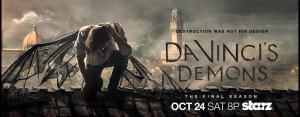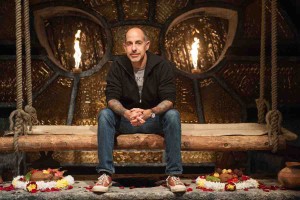The third and final season of Starz’s DA VINCI’S DEMONS, Saturdays at 8 PM, sees Leonardo Da Vinci, still a relatively young man played by Tom Riley, making weapons of war to defend Italy from the Turks.
David S. Goyer, who created DA VINCI’S DEMONS and is one of the executive producers, originally turned over the show-running reins for the third season to John Shiban because he was up to his eyebrows in other projects, including writing the screenplay for the much-anticipated BATMAN V. SUPERMAN and creating/running NBC’s CONSTANTINE, the TV series adaptation of D.C. Comics’ HELLBLAZER. However, as Goyer explains during a conversation at the Beverly Hills Four Seasons Hotel, his DEMONS wound up having some unanticipated gravitational pull.
DAVID S. GOYER: CONSTANTINE was starting, which obviously now got canceled, and BATMAN V SUPERMAN was happening, so there was a lot of stuff that pulled me away, but CONSTANTINE got canceled, and that freed me up a little of some of my bandwidth, so I came back in [to DEMONS]. I ended up coming back in during the end of production and post-production, so by the end, I was back in as much as I started.
ASSIGNMENT X: Constantine appeared, played by your CONSTANTINE lead Matt Ryan, on ARROW this season. Were you at all involved in that?
GOYER: Only so far as I was talking to [ARROW executive producers] Greg [Berlanti] and Andrew [Kreisberg] about the possibility of some kind of crossover or something like that, even if CONSTANTINE had continued, and so it was something that I was all for. Warner Brothers doesn’t need my permission, but I was happy to see it happen, especially for the fans, and I love Matt dearly and it’s nice to see that character at least live another episode.
AX: With DA VINCI’S DEMONS, how did you decide on John Shiban as your Season 3 show runner? Did you choose him, or did Starz pick him when you said, “I am not available”?
GOYER: No, what happened was, it was a mutual thing. There were maybe four serious candidates, and I ended up meeting with all of them, and John was the one that I felt the most comfortable with in terms of carrying the torch forward.
AX: By the end of Season 2, there were a lot of different story threads that were not overlapping …
GOYER: Well, yeah. That was the point of Season 2. Season 3, all those threads come back together and mesh together and collide in a very messy way.
AX: How much of Season 3 was laid out prior to actual work on the season?
GOYER: A fair amount, because by design, Season 3 was always going to involve the siege of Atranto, and the whole season takes place in a much more compressed timeline [than previous seasons], over the course of a month or so. And so that historical event was the framework for Season 3, and that was obviously something that we had set up at the end of Season 2. But having said that, John created some new wrinkles into the story that we were telling, and then the way that the story ended, once we decided to end the series, that was also the point in which I had come back in more heavily and ended up directing second unit for some of it and writing some of the final scenes.
AX: If Season 3 wasn’t been initially conceived as the series’ end, was it challenging to figure out, how do we end everybody so they’re pointed in the right direction towards actual history?
GOYER: It was and it wasn’t. Had we continued for Season 4, we had an idea that would have taken place during the Bonfire of the Vanities, which historically was about fourteen years after the events that take place in Season 3, so we always would have had a big time jump forward. So it wasn’t that complicated a decision, because there was a natural [break point], and there were a couple of historical figures that died around the time Season 3 ends, without revealing too much. So in that regard, it wasn’t that difficult pointing them in the right direction.
AX: Were there some historical events that happened later that you decided to pull forward, so you could depict them in Season 3?
GOYER: Not by much. Maybe by a couple of months or something like that, but nothing too crazy.
AX: What was the most challenging aspect of crafting Season 3? Was it just setting up a framework that somebody other than you could run with?
GOYER: To a certain extent. I mean, I think that that the show has always been very idiosyncratic, and I think it’s always been a little hard for me to translate that to anyone but me, but I think John did a really noble job, and like I said, when we decided it might be time to wrap up the show, it seemed like a natural place for me to step back in and work with him.
AX: Were there relationships that surprised you in how they evolved, for example, the one between Da Vinci and papal henchman Riario, played by Blake Ritson?
GOYER: Not Da Vinci and Riario. That was something that I’d intended even from Episode Two. To a certain extent, there’s also kind of a love affair going on between the two of them, in terms of Riario was always the only other character that I think fully grasped Leonardo’s genius, other than perhaps the Turk [played by Alexander Siddig]. I think the most surprising character was possibly Vanessa [played by Hera Hilmar], who wasn’t even in the first draft of the pilot, and then evolved from a character who wasn’t intended to be a series regular to a really elevated status in Season 3.
AX: And was Nico, played by Eros Vlahos, always going to turn out to be …
GOYER: Yes. He was always, always – we can say it – Machiavelli.
AX: Do we see more of that coming out in Season 3?
GOYER: Yes, a little bit. We start to see the BATMAN BEGINS version of Machiavelli, if you will.
AX: Do you think you might return to Machiavelli for another series later on in your creative life?
GOYER: That would be great, it would be fantastic to do a Machiavelli series. That would be really cool.
AX: Da Vinci winds up fighting against the Turks very hard. Is he opposed to the Turks on principle, because he’s mad at the Turk, or because he’s feeling sort of patriotic as an Italian, or …?
GOYER: You have to take it a little bit within the historical framework. I mean, yes, he is feeling patriotic as an Italian. At one point in the season, he says, “For a united Italy.” At the time, Italy was a series of kind of city-states. There wasn’t one unified country in the way that we know it today. And the Ottomans represented this existential threat to all of Europe at the time. But at the same time, we’ve taken great pains to point out, primarily through a character named Gedik [played by Stewart Scudamore], that that’s one view of the Ottomans. They were arguably the most advanced civilization in the world. They were certainly the greatest fighting force in the world at the time, and they had come up with a tremendous amount of scientific innovations in their own right. And so Gedik is the leader of the Ottoman force, who points out at one point to another character that a lot of what’s happening in Atranto is sort of a quid pro quo for some of the things that Europe visited upon the Middle East during the Crusades. One man’s terrorist is another man’s freedom fighter.
AX: Were you excited about producing what is essentially a war story?
GOYER: Yeah. I mean, the entire season revolves around a war story. It’s ten episodes to do a siege, and we did battles on a much bigger scale than anything we would have pulled off before. We couldn’t have done it the first season – we weren’t seasoned enough.
AX: Evidently there was sort of a close call with almost blowing up Mr. Riley …
GOYER: Oh, we’ve had many close calls with blowing up Mr. Riley [laughs]. He did most, if not all, of his own stunts, and we’re lucky he’s still with us. Quite a few things happened on that show.
AX: Were there any notable accidents where you all went, “We need to look at the way we’re doing this”?
GOYER: No. Everything was done with all sorts of appropriate safety measures. But having said that, there are pyrotechnics on this show, and you’ve got people on wires, and people doing real sword-fighting, and even with the most extreme caution you could take, accidents happen.
AX: Do you have a favorite episode or scene within the show?
GOYER: Ep Five, Season 1 is pretty great. That was the most daring one. That was the one in which Leonardo was put on trial for sodomy. That was a very controversial episode when we were making it, we’re proud that we did it. That was pretty cool.
AX: Do you have a favorite character within the show?
GOYER: Auggh. Well, I adore Tom – we’ve become good friends. I’m very partial to Zoroaster, played by Gregg Chillin. He’s great fun to write for and just a great human being. I will always have a soft spot in my heart for Al-Rahim, the Turk, who is played by Alexander Siddig. I adore him in real life. And Paul Rhys, who played Vlad Dracula, was just a great hoot in the first season.
AX: Was there anything that just turned out completely different than the way you’d imagined?
GOYER: Well, sometimes there are characters that take off. There is a character named Lupo Mercuri [played by Nick Dunning], who was not meant to be a recurring character, who was actually meant to die. In fact, we filmed his death scene in Episode Six of Season 1. And by that point, we’d seen the cut of Episode Three and the actor was so wonderful in that that we un-killed him. We filmed a new scene in which he didn’t die, and then he came back in Season 2, and we were supposed to kill him in Season 2, and then he came back in Season 3. It’s fun when that happens.
AX: Through much of DA VINCI’S DEMONS, Da Vinci is wrestling with his own artistic ego. Is any of that reflected in your thoughts about your own work, or did you learn anything about how you look at your own work through the process of doing this?
GOYER: It’s something that I certainly identify with. Any inventor or any creator has to wrestle with, when you’re creating, you’re essentially working with yourself or maybe one collaborator, and it’s something completely internal, and then when it gets made, whether it’s a film or a TV show, an invention, it’s not just yours any more. It’s released into the world and other people take possession of it, and other people interpret it in different ways, and sometimes they interpret it in a way that you intended it to be interpreted, and sometimes they interpret it in a different way. And so there’s always going to be a tension between pure acts of creation, and the act of giving it to the greater world.
AX: Has doing DA VINCI’S DEMONS changed your view of anything in the real world, either how art is created, or why wars are waged, or …?
GOYER: I’d like to think that I was fairly tolerant before of opposing points of view, but it’s made me more tolerant. I would also say that we think of Leonardo Da Vinci as this genius, he’s the model for the Renaissance man, but he was plagued with self-doubt. And so having the opportunity to actually hold in my hands some of his actual journal pages and see the little notes that he made to himself, the questions that he asked of himself, it made me appreciate the fact that even these people that we put on a pedestal are real human beings.
AX: Can you say anything at all about THE FOREST, the horror movie you executive-produced in Japan, and/or BATMAN V SUPERMAN?
GOYER: BATMAN V SUPERMAN, I can say that they fight [laughs], hence the title “versus,” that’s about it. They clash, if you will. THE FOREST, I was just in London with [the film’s star] Natalie Dormer, she’s fantastic in the movie, I think it’s a really scary movie, I’m really proud of it, it comes out early January. It should be good.
AX: Did you have to learn anything about Japanese folklore for THE FOREST?
GOYER: Yeah, absolutely. A lot. In fact, we were doing some recording for the soundtrack of Japanese singers in Tokyo with Japanese folk songs.
AX: What do you hope people will come away with from DA VINCI’S DEMONS at the end of the series?
GOYER: I hope they feel that it was a unique show, I hope they have a greater appreciation for history, that they don’t feel it’s something that’s necessarily dry, that it can be fun. I hope it can be an inspiration for other people to create something kind of different and unique.
I’m incredibly appreciative of the opportunity. I loved making the show. It was a real privilege to do it, I’m glad it touched so many people, and I hope the fans, the audience, are satisfied with the closure that we brought to it.
Related: Exclusive Interview with DA VINCI’S DEMONS’ Tom Riley on the third and final season
Follow us on Twitter at ASSIGNMENT X
Like us on Facebook at ASSIGNMENT X
Article Source: Assignment X
Article: Exclusive Interview with DA VINCI’S DEMONS’ creator David S. Goyer on the final season
Related Posts:













